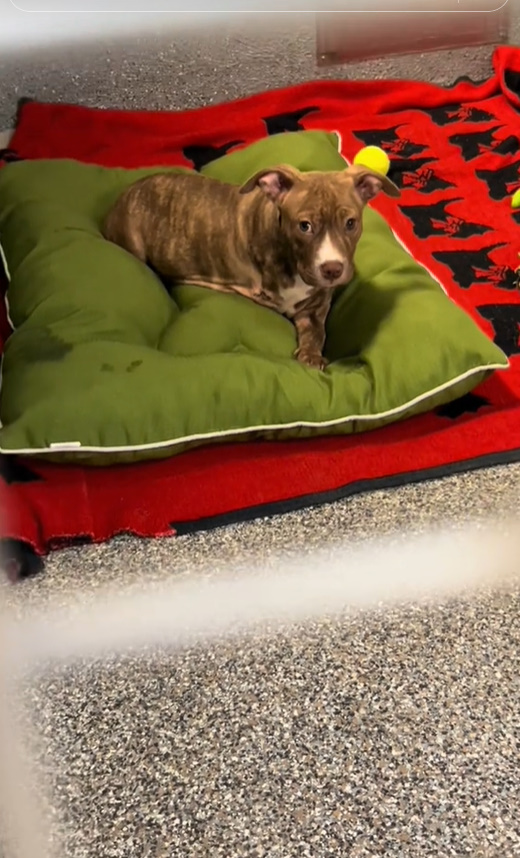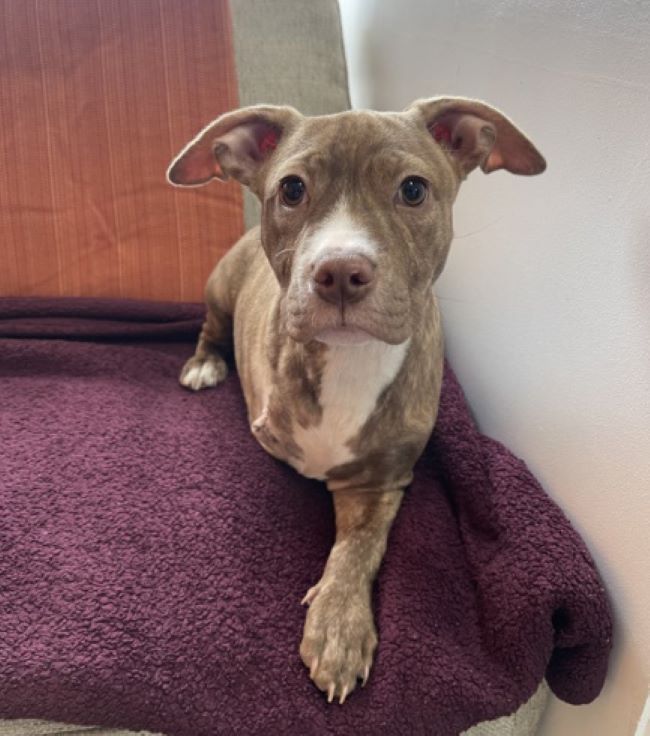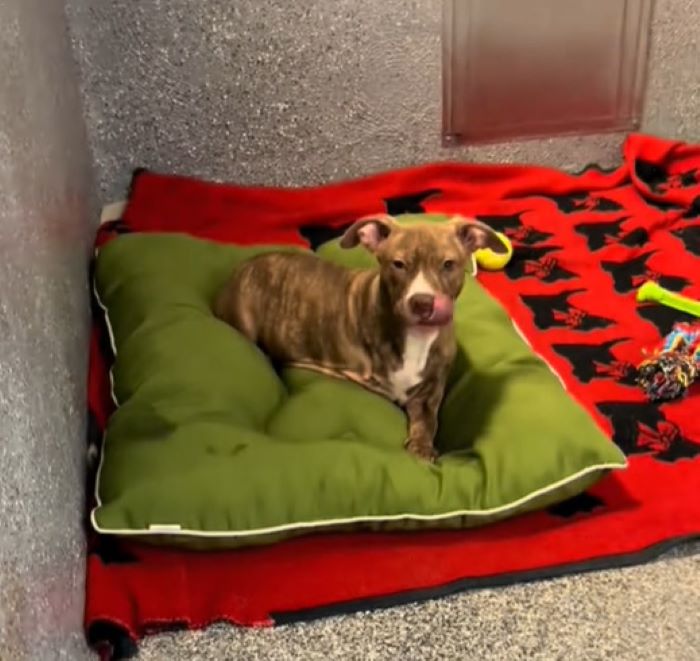Rescuing or adopting a dog who has special needs or has some form of disability is one of the most heroic things a person can do.
Despite the hardships they have to overcome throughout their lives, they are still our lovable furry friends, and they deserve a loving home.
Nothing should deprive them of this. But, the reality is different and the cold truth is that people always avoid dogs who have disabilities.
While it doesn’t have to be like that, it’s certainly the case for Ranch, the three-legged dog who receives no visitors but only wants to find a loving family.
Ranch’s Background

When Ranch was first found by animal control, she was just a stray dog wandering around the streets of California.
She was then transferred to Valley Animal Center, in Fresno, where she stayed for a long time because she was unable to find a home.
When the doctors at the centre first met her, they realized that she had a congenital deformity on one of her legs, and it was best that they amputate it.

While it’s a horrible thing to think about, it was absolutely necessary for her well-being as it inhibited her movement and caused other problems as well.
Ruben Cantu, who works at the centre, told Newsweek: “Our doctors felt that it was in the best interest of Ranch to amputate the leg as it would potentially cause more mobility or growth issues in the future.”
Despite having only three legs now, Ranch has adapted very well. The staff helped her adjust to it every step of the way.
Cantu Remains Hopeful

Everyone was so proud of the progress she made and they were confident she would be okay despite her disability.
Cantu continues by saying: “Before her surgery, she would attempt to walk with all four paws and would typically trip and fall over, now she moves around much better and is healing great.“
The staff was confident that she would receive some potential visitors or adopters.
A volunteer working for the shelter in California posted a video about Ranch and noted that she has had no visitors since she arrived, which was so heartbreaking.
While she is very lovable and sweet in every way, a lot of people just can’t see themselves adopting a three-legged dog.
Even though she is still looking for a forever home, Cantu remains optimistic about her prospects.
He said: “I am hopeful that she will find a home quickly, but I think her biggest hinder is that she will be a large breed dog who is considered disabled. There may be extra care that arises in the future as she ages.”
While her situation may seem a bit concerning, Ranch is in the care of some truly amazing people who are working around the clock to help her find a family and lead a normal life.
If you’ve ever leaned in for a cuddle with your furry friend and caught a whiff of something oddly familiar, you’re not alone. That distinct scent that sometimes makes dogs smell like Fritos is a curious mystery that many pet owners have pondered. It’s like a blend of corn chips and puppy paws that can leave you both puzzled and amused. You may find yourself wondering what causes this quirky phenomenon every time your canine companion curls up next to you.
As a seasoned dog enthusiast, you’ve likely encountered this intriguing aroma more than once. The way your pup’s natural scent can sometimes mimic a bag of salty snacks is both endearing and puzzling. While it may seem like a quirky quirk of our beloved four-legged friends, there’s more to this phenomenon than meets the nose.
Understanding the Frito Feet Phenomenon in Dogs
The Science Behind the Smell
Dogs’ paws naturally host yeast and bacteria. When these microorganisms mix with sweat, they create a distinctive odor resembling Fritos. This smell is more noticeable in certain breeds due to their skin folds or moisture retention in their paw pads.
Factors Contributing to the Corn Chip Aroma
Various factors contribute to the corn chip aroma in dogs. Diet plays a role; certain foods can alter a dog’s natural scent. Additionally, environmental factors like walking on surfaces that trap smells or bacteria can intensify the Frito-like odor. Regular cleaning of your dog’s paws and ensuring a balanced diet can help manage this peculiar yet common phenomenon.
The Role of Bacteria and Yeast
How Microorganisms Affect Dog’s Paws
Bacteria and yeast naturally live on your dog’s skin, including their paws. When these microorganisms come into contact with the sweat on the paws, they create a distinctive odor similar to Fritos. The warm and moist environment between the paw pads provides an ideal breeding ground for these microorganisms.
Common Types of Bacteria Found on Canine Feet
Some common bacteria found on your dog’s feet include Staphylococcus and Pseudomonas. These bacteria are part of the natural flora of the skin and are generally harmless. However, when they mix with sweat and yeast, they can contribute to the Frito-like smell that many dog owners notice. Regular paw cleaning can help manage the growth of these microorganisms and reduce the smell.
Dog’s Diet and Frito-Like Odor
Foods That May Influence Paw Scent
When it comes to the intriguing “Frito Feet” smell in dogs, their diet can also play a part. Certain foods can influence the scent emanating from your furry friend’s paws. Foods high in corn or cornmeal might contribute to a stronger Frito-like smell in some dogs. This is because the corn and corn-based ingredients can be broken down by the body and end up affecting the way your dog’s paws smell. Monitoring your dog’s diet, especially the ingredients that may contain corn, could help manage this unique scent.
Nutritional Factors and Body Odors
Nutrition plays a crucial role in your dog’s overall health, including their body odors. A well-balanced diet rich in essential nutrients can help regulate your dog’s body chemistry, potentially affecting their natural odors, including the Frito-like smell. Ensuring your furry companion is getting the right nutrients can aid in controlling any unusual smells, including those coming from their paws. Consulting with your veterinarian about your dog’s diet and potential nutritional factors that may influence their body odors can be beneficial in maintaining their overall well-being.
Grooming Habits and Paw Scent
The Importance of Regular Paw Cleaning
When it comes to dealing with your furry friend’s distinctive Frito-like paws, regular paw cleaning is key. By keeping your dog’s paws clean, you can help reduce the buildup of sweat, bacteria, and yeast that contribute to that corn chips odor. A simple wipe-down with a damp cloth after walks or playtime can go a long way in minimizing the smell and ensuring your dog’s paws stay fresh.
Grooming Products That Can Alter Paw Smell
Choosing the right grooming products can also play a role in altering your dog’s paw scent. Opt for gentle shampoos and paw balms that contain natural ingredients to help maintain paw health and keep any unwanted odors at bay. Look for products specifically designed for paw care to ensure you’re addressing the root cause of the odor and not just masking it. Regular grooming routines, including paw maintenance, can make a significant difference in how your dog’s paws smell.
Health Implications of the Frito Odor
When Should You Worry About Your Dog’s Smell
If the Frito-like smell becomes overpowering or changes suddenly, it may indicate an underlying health issue. Keep an eye out for additional symptoms such as redness, inflammation, or limping, which could signal a more serious concern. Consult your vet promptly if you notice any concerning changes in your dog’s odor or overall health to address potential issues promptly.
Vet-Recommended Solutions and Treatments
When dealing with persistent Frito odor in your dog, it’s best to seek advice from your veterinarian. They may recommend specialized shampoos or wipes to target the specific causes of the smell, such as yeast or bacterial overgrowth. In some cases, dietary adjustments or supplements could help regulate your dog’s body chemistry and reduce the intensity of the Frito scent. By following your vet’s guidance and maintaining a consistent grooming routine, you can help manage the odor effectively and ensure your dog’s overall well-being.
Conclusion
So, next time you catch a whiff of your dog’s Frito feet, remember it’s a quirky mix of yeast, bacteria, and sweat at play. Factors like diet, environment, and breed characteristics all contribute to this distinct smell. Maintaining a balanced diet and consulting your vet are key to keeping your furry friend healthy and odor-free. If the corn chips odor becomes too strong or changes suddenly, it might be a sign to seek professional advice. With vet-approved solutions like special shampoos and dietary tweaks, you can manage the smell and ensure your pup’s well-being. Don’t forget, regular paw cleaning and grooming routines go a long way in minimizing that Frito fragrance.
Frequently Asked Questions
What is the “Frito Feet” phenomenon in dogs?
“Frito Feet” is a term used to describe the corn chips-like smell that some dogs’ paws emit. Factors like yeast, bacteria, sweat, diet, and environment contribute to this distinct odor.
Why do some dogs have the “Frito Feet” smell?
Yeast and bacteria growth, coupled with sweat accumulation, can cause the Frito odor in dogs, especially in breeds with skin folds or moisture-retaining paw pads. Diets high in corn or cornmeal can also intensify the smell.
How can you help manage the “Frito Feet” smell in dogs?
Maintaining a balanced diet, regular paw cleaning, and grooming can help control the odor. Consulting a vet for dietary adjustments or specialized shampoos is recommended for odor management and overall pet health.
When should I be concerned about my dog’s “Frito Feet” smell?
If the odor becomes overwhelming or changes suddenly, it might indicate underlying health issues. Prompt vet consultation ensures proper diagnosis and treatment if needed.
[no_toc]

Hey there, I’m Janet Brooks, a dog-loving student from California. I’m all about helping pups in need, especially those without homes. Me and my awesome friends work together to give shelter and love to stray dogs. Oh, and I also write blogs about dogs to share helpful info.